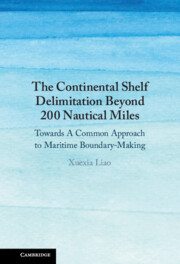Description
The Continental Shelf Delimitation Beyond 200 Nautical Miles
Towards A Common Approach to Maritime Boundary-Making
Author: Liao Xuexia
Language: English
Subject for The Continental Shelf Delimitation Beyond 200 Nautical Miles:
Approximative price 121.50 €
In Print (Delivery period: 14 days).
Add to cart
Publication date: 10-2021
Support: Print on demand
Support: Print on demand
Description
/li>Contents
/li>Biography
/li>
The Continental Shelf Delimitation Beyond 200 Nautical Miles provides an up-to-date and informed analysis of the now fast developing, yet confusing, field of the law of maritime delimitation. It examines the procedural matters in relation to the competence of international courts and tribunals in the light of the institutional framework of the United Nations Convention on the Law of the Sea and discusses the methodological questions arising out of the delimitation process. The book engages with the key concepts of maritime entitlement, delineation and delimitation with a view to developing a coherent and consistent approach to the delimitation of the continental shelf beyond 200 nautical miles. Essentially, it argues that the delimitation of the continental shelf will be unified with existing maritime delimitation, and a common approach to maritime boundary-making within and beyond 200 nautical miles is likely to emerge.
List of Figures; Table of Cases; Table of Treaties; Abbreviations; 1. Legal uncertainties in the continental shelf delimitation beyond 200 nm; Part I. Overlapping Entitlements to The Continental Shelf Beyond 200 Nautical Miles: 2. Establishing the entitlement to the continental shelf beyond 200 nm; 3. Defining overlapping entitlements to the continental shelf beyond 200 nm; 4. Interaction between delineation and delimitation of the continental shelf beyond 200 nm; Part II. Delimitation Methodology for The Continental Shelf Beyond 200 Nautical Miles: 5. Conceptual framework of delimitation methodology; 6. Determination of the area of overlapping entitlements; 7. Geomorphological and geological circumstances; 8. Geographical circumstances; 9. Towards a common approach to maritime delimitation within and beyond 200 nm; Appendix 1; Appendix 2; Appendix 3; Appendix 4; Bibliography; Index.
Xuexia Liao is an assistant professor at Peking University Law School. She completed her doctoral studies in International Law at the Graduate Institute of International and Development Studies, Geneva and was awarded the Diploma of the Hague Academy of International Law (2016). She was also the winner of the Writing Prize of International Cable Protection Committee in 2018.
© 2024 LAVOISIER S.A.S.




